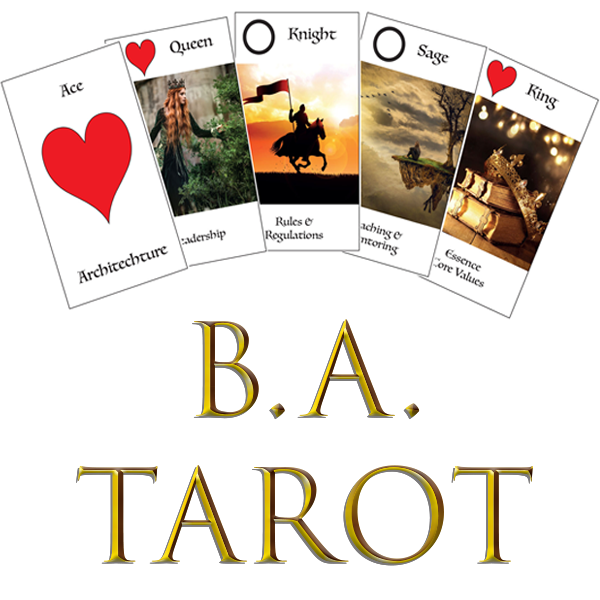
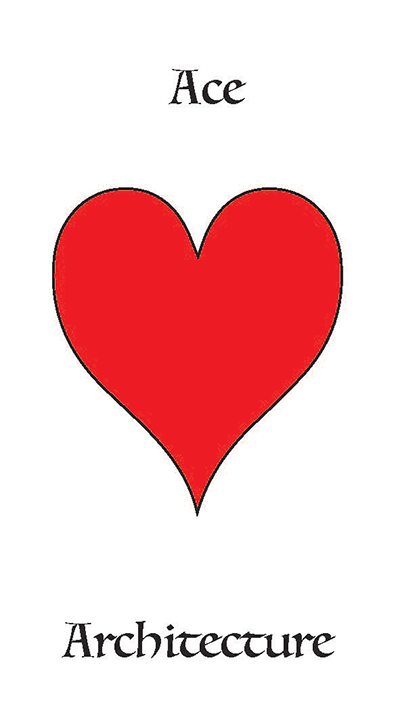
The Hearts suit focuses on the organisation’s core elements. The businesses ability to react to a changing environment. Its leadership, culture and attitude. Business Architecture establishes a foundation to the business.
The Business Architecture Working Group of the Object Management Group (OMG) (2010) describes it as “a blueprint of the enterprise that provides a common understanding of the organisation and is used to align strategic objectives and tactical demands. According to the OMG describes “the structure of the enterprise in terms of its governance structure, business processes, and business information.” As such, the profession of business architecture primarily focuses on the motivational, operational, and analysis frameworks that link these aspects of the enterprise together.
This is often the first suit used, by establishing the overall strategy of the organisation. (Corporate Strategy)
Note: All suits can be used to consider all strategy levels but Architecture is often about the corporate level strategy
The other suits are all appropriate for understanding and eliciting the overall strategy and context or the organisation.
The Original Architecture has been replaced with Organisation in the V3.0 versions
On the reverse of the V3.0 cards are:
- Ability to change
- The Environment the organisation creates
- Its Governance
- Its capabilities
- The value it delivers
- The result of its collective effort

The Castle: Represents Organisational Health an organisation’s ability to function effectively, to cope adequately, to change appropriately, and to grow from within. Without a focus on the well-being of the organisation the foundations crumble. Healthy companies compete effectively against their competition.
They are represented by companies that:
- Have a shared vision
- Operate with transparency
- are consultative
- Supportive
- Have professional standards
- Develop talent
- Customer focussed
The Original Organisational Health has been replaced with Function in the V3.0 versions. This is because many people are using the cards for projects and Function is much more applicable, not only to an organisation but a project or initiative.
On the reverse of the card are:
- What the business does well at or excels at.
- It’s core Functions (Production, Sales, Finance,HR, Innovation)
- The support functions (Administration, Training Procurement)
- the outcomes of its Function – Output
- It’s Aspirations, “to be the best? Fastest? Highest Quality”
- It’s uniqueness, What makes it unique, special or different?
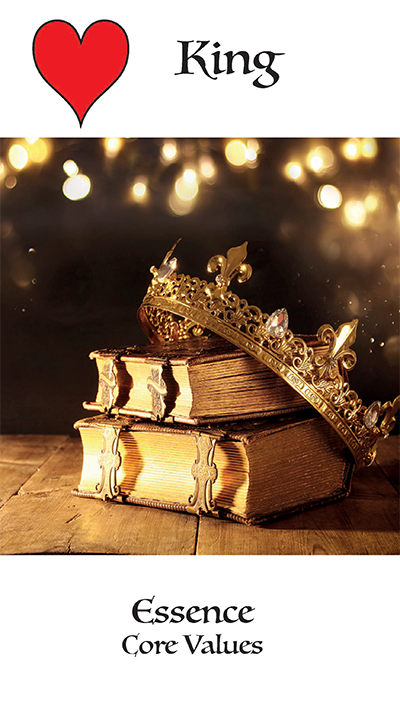
The King: Essence
Represents the Organisations Core Values. I call this the “Organisation Essence”. The essence is what the business believes in , why it exists and it’s beliefs. Every business has a central attitude and outlook or persona. Although much of this comes from the vision of the owner or leaders of the business it is important that the essence is found at all levels of the organisation. Everyone within the business should be able to communicate the organisations essence. People with similar values like to work with or work within an organisation that is like themselves. The essence is what makes the business what it is.
The Original Essence has been replaced with Focus in the V3.0 versions. I felt that this was more applicable to both a project and an organisation. Organisational focus was a better and more general word than Essence for project applications.
On the reverse of the card are:
- Business drivers – Who maintains focus?
- Market drivers – What external influences required the focus of the business
- Clarity, is the business clear about its focus/ aim/ vision?
- Motivations of people, owners, departments.
- Goals – How are goals measured, reviewed (personal or organisational)
- Deliverables, what does the focus deliver?
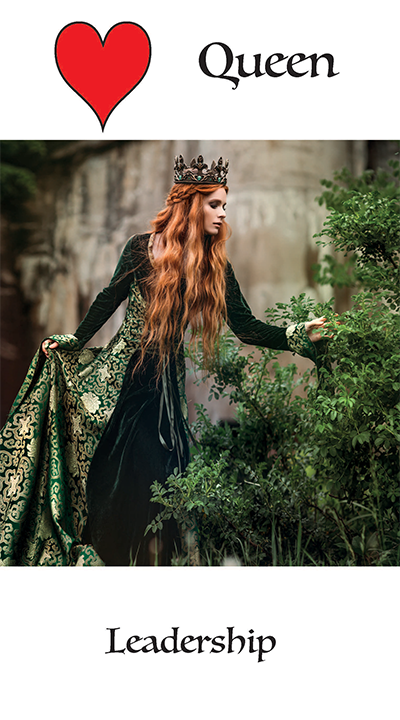
The Queen: Leadership
Leadership is often seen as the figurehead of an organisation. In this instance the card is not it is about the figurehead it is about ownership of a problem, it is about inner leadership of an individual, it is about creating an environment where other leaders can flourish. I met Deanna Oppenheimer a few times and I have continued to quote her she said ” When you walk away from a great manager you think WoW they are great, but when you walk away from a great leader you think WoW I’m Great !”
The Original Leadership has been replaced with Ownership in the V3.0 versions. As this appeals to all levels of the organisation, often leadership is considered “for them upstairs” rather than everybody.
On the reverse of the card are:
- Advocacy – advocacy is the process of taking action to support a cause. (The Project)
- Subject matter Expert – Identifying them and getting them to take ownership of an initiative.
- Decision Making, who is responsible, are the key decisions being made?
- Risk assessment. Balancing risk with opportunity
- Assurance and Quality – who owns the definition of good or done
- Roles and permissions – how the business allocates permission.
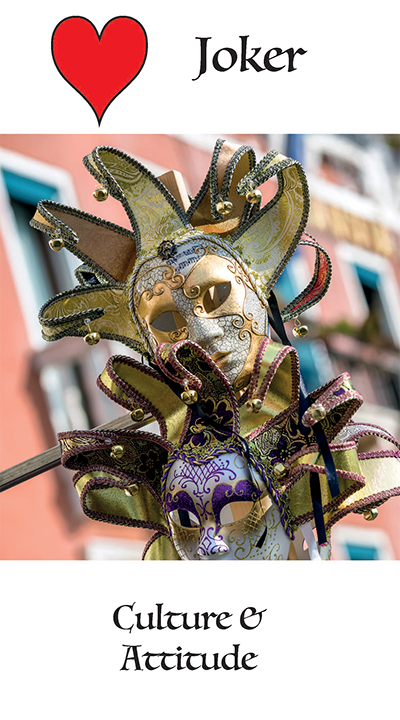
The Joker: Culture and Attitude
The joker is intentionally used even though people think that this character is comic. This is not the case the joker in the kings court was used to represent the voice of the people – the joker could say things in jest to the king that others would be unable to say. The joker represents the “true word spoken”. Culture and attitude of the organisation is difficult to measure but should be one of the focus points for the business. Rene Carayol once said that “Culture eats strategy for breakfast” if you get the culture right the strategy will follow, no amount of strategy will change culture.
This card is Method in the Mad about CRM and the V3.0 versions.
The Original Culture has been replaced with Method in the V3.0 versions. Although culture and attitude is important, when considering projects and the immediate changes needed, we felt methodology and its variations more useful.
On the reverse of the card are:
- In House – will it all be in house ?
- Are there out house suppliers influencers?
- Iterative vs Incremental
- Quality, Speed, Price (pick 2)
- Feature Driven vs User Driven
- Critical Nature of the project (Scale/ Difficulty could influence method)
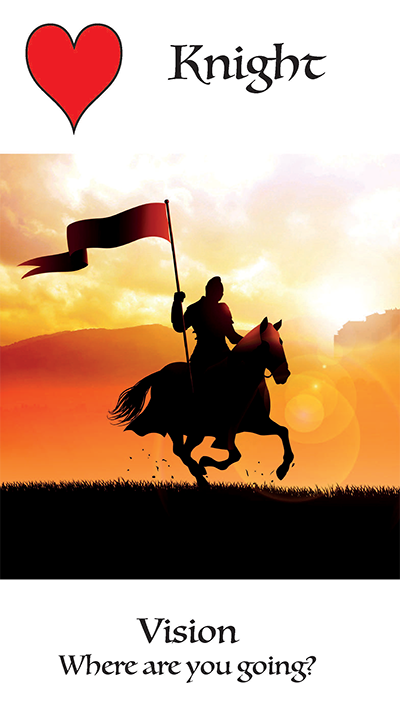
The Knight: Vision
Knowing where you are going or at least the dream that you have as a business is what this card represents.
Martin Luther King – Never said I have a Plan !
An organisation that sets goals and has a vision will naturally collect like minded people. By setting your DREAM and communicating that dream, people will understand why they are doing what you ask of them. Like martin Luther King using the phrase “I believe” helps to reinforce that dream. A company that has a clear vision that is communicated throughout the business will thrive. Dreams don’t have to be across an entire organisation departments and individuals can have their own vision and dreams.
This card is still Vision in the V3.0 versions.
On the reverse of the card are:
- Shared Values – does everyone have the same vision?
- Mission – Mission statement or definition
- Make the vision – vivid, motivating and memorable
- Uniqueness, has it been done before? Why is the vision different?
- Culture and tone of voice – The vision should include aspects of culture
- Martin luther king dod not say “I have a plan” – define the dream no matter how small.

The Sage: Context
The sage represents the overall business context that encompasses an understanding of the factors impacting the business from various perspectives of stakeholders. (Including how decisions are made and what the business is ultimately trying to achieve.) The card represents the requirement of everyone within the business to have a common understanding of the environment that the organisation is operating within, a consensus on what it is trying to achieve and an environment of cooperation both internally and externally.
This card is still Context in the V3.0 versions.
On the reverse of the card are:
- Common understanding
- Actors – both the sender and the reciever of the activity
- Perspectives – consider different perspectives
- How does the context fit with the Community (customer community, organisation community)
- Environment influences – Political, Economic, Social , Technical, Legal, Ethical
- The situation – clear understanding of all aspects
